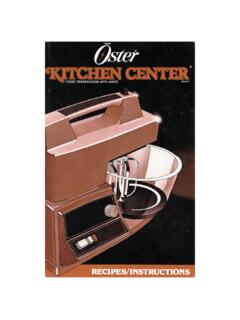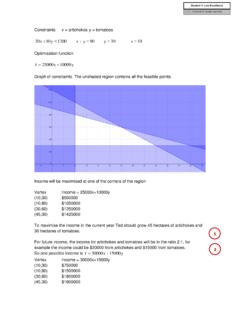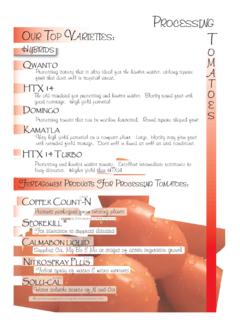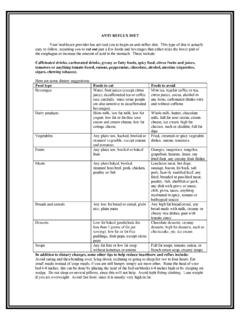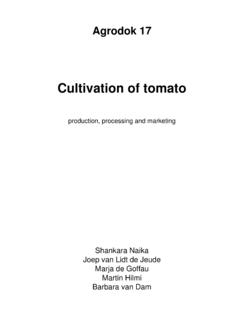Transcription of PickYourOwn
1 Where you can find a pick-your-own farm near you! . Click on the printer icon that looks like this: (at the top left, to the right of save a copy ) to print! See for many other canning directions and recipes How to Make Home-canned tomatoes from Fresh tomatoes ! Making canned tomatoes is something families remember years later. Home- canned tomatoes have been a tradition for many generations. In the middle of the winter, you can use the tomatoes to make a fresh spaghetti sauce, lasagna, chili, or other tomato-based meals for that fresh garden taste. Here's how to do it, in easy steps and completely illustrated. This method is so easy, ANYONE can do this! It's a great thing to do with your kids! If you have a pressure canner, you may want to see the pressure canning tomatoes page for those directions instead! And if you'd rather freeze your tomatoes , see this page! All images and text Copyright Benivia, LLC 2004,2005, 2006, 2007, 2008 All rights reserved.
2 Page 1 of 12. Ingredients and Equipment tomatoes - about 20 lbs to make 7. quarts (7 large tomatoes will fill one quart jar.) Pint or quart canning jars (Ball or lemon juice - fresh or bottled, Kerr jars can be found at Publix about 1/2 cup and Wal-Mart - about $8 per 1 quart tomato juice (or plain dozen jars including the lids and water) rings). Quart jars are more 1 Water bath Canner (a huge pot economical! to sterilize the jars after filling Lids - thin, flat, round metal lids (about $30 to $35 - $30 at mall with a gum binder that seals them kitchen stores, Wal-Mart. Note: against the top of the jar. They we sell many sizes and types of may only be used once. canners for all types of stoves and Rings - metal bands that secure needs - see canning supplies). the lids to the jars. They may be tomatoes are on the border reused many times. between the high-acid fruits that Jar grabber (to pick up the hot can be preserved in a boiling-water jars). bath and the low-acid fruits, Lid lifter (has a magnet to pick the vegetables and meats that need lids out of the boiling water where pressure canning you sterilize them.))
3 ($2 at Wal- 1 large pot (to scald the tomatoes , Mart). step 3) and 1 medium sized pot to Jar funnel ($3-$4 at Wal-Mart). heat the tomato juice or water to Large spoons and ladles add to the jars (step 6) and 1. small pot to sterilize the lids. All images and text Copyright Benivia, LLC 2004,2005, 2006, 2007, 2008 All rights reserved. Page 2 of 12. Process - How to Make Home Canned tomatoes from Fresh tomatoes Step 1 - Selecting the tomatoes It's fun to go pick your own and you can obviously get better quality tomatoes ! At right is a picture of tomatoes from my garden - they are so much better than anything from the grocery store. And if you don't have enough, a pick-you-own farm is the pace to go! At right are 4 common varieties that will work: Top right: Top left: Lemon Boy, Beefsteak yellow Bottom left: Bottom Roma, paste- right: Better type Boy The picture at right shows the best variety of tomato to use: Roma; also called paste tomatoes . They have fewer sides, thicker, meatier walls, and less water.
4 And that means thicker sauce in less cooking time! Also, you don't want mushy, bruised or rotten tomatoes ! And for those of you with an abundance of green tomatoes , the USDA says that since green tomatoes are more acidic than ripened fruit, they can be canned safely with any of the standard tomato directions. I prefer to store them in the basement, where they slowly ripen, but if you have a use later for canned green tomatoes , go for All images and text Copyright Benivia, LLC 2004,2005, 2006, 2007, 2008 All rights reserved. Page 3 of 12. Step 2 - Get the jars and lids sterilizing The dishwasher is fine for the jars;. especially if it has a "sterilize". cycle. I get that going while I'm preparing everything else, so it's done by the time I'm ready to fill the jars. If you don't have a dishwasher, submerge the jars in a large pot (the canner itself) of water and bring it to a boil. Be sure to let it go through the rinse cycle to get rid of any soap! Get the canner heating up Fill the canner about 1/2 full of water and start it heating (with the lid on).
5 Get a the medium pot of water or tomato juice heating This is also a good time to get your 1 quart of tomato juice and/or water boiling (you will use it to fill any air spaces in the jars in step 6). All images and text Copyright Benivia, LLC 2004,2005, 2006, 2007, 2008 All rights reserved. Page 4 of 12. Start the water for the lids Put the lids into the small pot of boiling water for at least several minutes. Note: everything gets sterilized in the water bath (step 7) anyway, so this just helps to ensure there is no spoilage later!). Step 3 - Removing the tomato skins Here's a trick you may not know: put the tomatoes , a few at a time in a large pot of boiling water for no more than 1 minute (30 - 45 seconds is usually enough). Plunge them into a waiting bowl of ice water. This makes the skins slide right off of the tomatoes ! If you leave the skins in, they become tough and chewy in the sauce, not very pleasant. All images and text Copyright Benivia, LLC 2004,2005, 2006, 2007, 2008 All rights reserved.
6 Page 5 of 12. Step 4 - Removing the skins, bruises and tough parts The skins should practically slide off the tomatoes . then you can cut the tomatoes in quarters and remove the tough part around the stem and any bruised or soft parts. Step 5 - Fill the jars with the whole or cut tomatoes Fill them to within -inch of the top with tomatoes Be sure the contact surfaces (top of the jar and underside of the ring) are clean to get a good seal! Step 6 - Add 2 Tablespoons of lemon juice and liquid After you fill each jar with tomatoes , add 2 tablespoons of lemon juice. This helps to reduce the odds of spoilage and to retain color and flavor. Then fill to 1/2 inch of the top with either boiling water or hot tomato juice. Step 7 - Free any trapped air bubbles Using a flat plastic or wood utensil (like a plastic spoon, up side down) free trapped air bubbles by gently sliding it up and down around the inside edge. All images and text Copyright Benivia, LLC 2004,2005, 2006, 2007, 2008 All rights reserved.
7 Page 6 of 12. Step 8 - Put the lids and rings on Just screw them on snugly, not too tight. If the is any tomato on the surface of the lip of the jar, wipe it off first with a clean dry cloth or paper towel. Step 9 - Boil the jars in the water bath canner Put them in the canner and keep them covered with at least 1 inch of water. Keep the water boiling. Process the jars in a boiling-water bath for 40 minutes for pints and 45 minutes for quarts. Remember to adjust the time if you are at a different altitude other than sea level! Pressure canners work better for tomatoes and other low acid foods - you'll get less spoilage with a pressure canner. I prefer a pressure canner as the higher temperatures and shorter cooking time result in better flavor and less spoilage. For more information or to order one, click on Pressure Canners. The recipe and directions for pressure canning tomatoes are here. All images and text Copyright Benivia, LLC 2004,2005, 2006, 2007, 2008 All rights reserved.
8 Page 7 of 12. Recommended process time for Crushed tomatoes in a boiling-water canner. Process Time at Altitudes of Style of Jar 0 - 1,000 1,001 - 3,001 - Above 6,000. Pack Size ft 3,000 ft 6,000 ft ft Pints 35 min 40 45 50. Hot Quarts 45 50 55 60. Step 10 - Done Lift the jars out of the water and let them cool without touching or bumping them in a draft-free place (usually takes overnight). You can then remove the rings if you like. Once the jars are cool, you can check that they are sealed verifying that the lid has been sucked down. Just press in the center, gently, with your finger. If it pops up and down (often making a popping sound), it is not sealed. If you put the jar in the refrigerator right away, you can still use it. Some people replace the lid and reprocess the jar, then that's a bit iffy. If you heat the contents back up, re-jar them (with a new lid) and the full time in the canner, it's usually ok. Don't worry if you see the tomatoes floating above a layer of liquid; that's normal.
9 tomatoes have a lot of water in them and it separates a bit. If I had packed the tomatoes in the jars a bit tighter or squeezed for of the free liquid out of them before packing them in the jars, the water layer would be reduced. All images and text Copyright Benivia, LLC 2004,2005, 2006, 2007, 2008 All rights reserved. Page 8 of 12. Frequently Asked Questions about Canning tomatoes Why do my tomatoes separate from the liquid? A frequent problem is the separation of water from the tomatoes . Why does the water separate from the solids in tomatoes ? Scenario 1 - liquid at the top and solids at the bottom Home canned tomatoes , tomato juice, and tomato sauces with liquid at the top and solids at the bottom is quite normal. It only reflects that the juice was made prior to heating. For example, the tomatoes were chopped, run through the steamer, sieve, or food mill while still raw and prior to heating. As soon as they are chopped or crushed, enzymes start to break down the pectin that helps to hold tomato cells together.
10 The enzyme that causes separation is activated by exposure to air and inactivated by heat. In commercial production, tomatoes are flash heated nearly to boiling in a matter of seconds, using equipment not available to consumers. Because the pectin holding tomato cells together is not exposed to air when cold, it remains intact, and a thick bodied, homogeneous juice is produced. The solution is to leave tomatoes whole or in large chunks (do not chop). Heat before chopping or juicing to minimize the separation. The best way to do that at home is to heat quartered tomatoes quickly to boiling temperatures WHILE crushing. You can also heat the blanched, peeled whole tomatoes in the microwave, then crush them! Make sure the mixture boils constantly and vigorously while you add the remaining tomatoes . Simmer 5 minutes after all tomatoes are added, before juicing. If you are not concerned about juice separating, simply slice or quarter tomatoes into a large saucepan.


